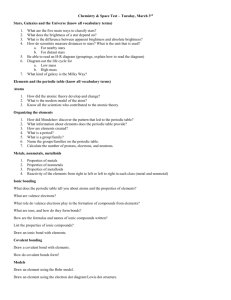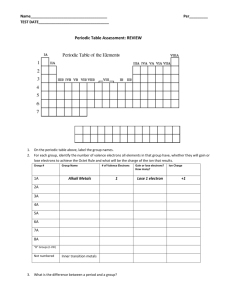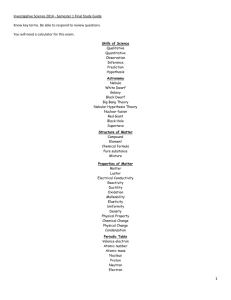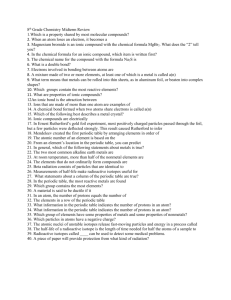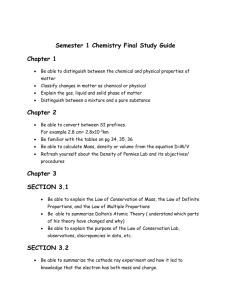Chemistry Common Exam Study Guide and Checklist
advertisement
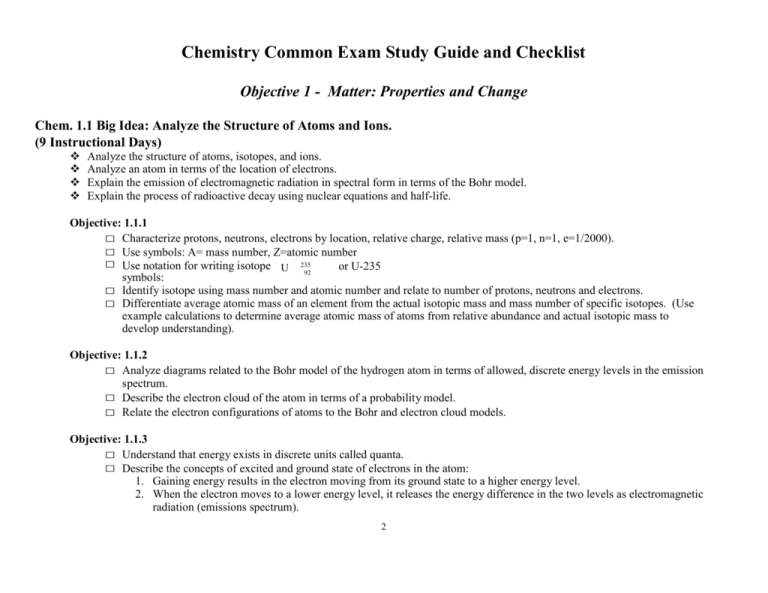
Chemistry Common Exam Study Guide and Checklist Objective 1 - Matter: Properties and Change Chem. 1.1 Big Idea: Analyze the Structure of Atoms and Ions. (9 Instructional Days) Analyze the structure of atoms, isotopes, and ions. Analyze an atom in terms of the location of electrons. Explain the emission of electromagnetic radiation in spectral form in terms of the Bohr model. Explain the process of radioactive decay using nuclear equations and half-life. Objective: 1.1.1 □ Characterize protons, neutrons, electrons by location, relative charge, relative mass (p=1, n=1, e=1/2000). □ Use symbols: A= mass number, Z=atomic number □ Use notation for writing isotope U 235 or U-235 92 symbols: □ Identify isotope using mass number and atomic number and relate to number of protons, neutrons and electrons. □ Differentiate average atomic mass of an element from the actual isotopic mass and mass number of specific isotopes. (Use example calculations to determine average atomic mass of atoms from relative abundance and actual isotopic mass to develop understanding). Objective: 1.1.2 □ Analyze diagrams related to the Bohr model of the hydrogen atom in terms of allowed, discrete energy levels in the emission spectrum. □ Describe the electron cloud of the atom in terms of a probability model. □ Relate the electron configurations of atoms to the Bohr and electron cloud models. Objective: 1.1.3 □ Understand that energy exists in discrete units called quanta. □ Describe the concepts of excited and ground state of electrons in the atom: 1. Gaining energy results in the electron moving from its ground state to a higher energy level. 2. When the electron moves to a lower energy level, it releases the energy difference in the two levels as electromagnetic radiation (emissions spectrum). 2 □ Articulate that this electromagnetic radiation is given off as photons. □ Understand the inverse relationship between wavelength and frequency, and the direct relationship between energy and frequency. □ Use the “Bohr Model for Hydrogen Atom” and “Electromagnetic Spectrum” diagrams from the Reference Tables to relate color, frequency, and wavelength of the light emitted to the energy of the photon. □ Explain that Niles Bohr produced a model of the hydrogen atom based on experimental observations. This model indicated that: 1. an electron circles the nucleus only in fixed energy ranges called orbits; 2. an electron can neither gain or lose energy inside this orbit, but could move up or down to another orbit; 3. that the lowest energy orbit is closest to the nucleus. □ Describe the wave/particle duality of electrons. Objective 1.1.4 □ Use the symbols for and distinguish between alpha ( 24He), and beta ( -10e) nuclear particles, and gamma () radiation include relative mass). □ Use shorthand notation of particles involved in nuclear equations to balance and solve for unknowns. □ Compare the penetrating ability of alpha, beta, and gamma radiation. □ Conceptually describe nuclear decay, including: 1. Decay as a random event, independent of other energy influences 2. Using symbols to represent simple balanced decay equations 3. Half-life (including simple calculations) □ Compare radioactive decay with fission and fusion. Chem. 1.2 Big Idea: Understand the Bonding That Occurs in Simple Compounds in Terms of Bond Type, Strength, and Properties. (9 Instructional Days) Compare (qualitatively) the relative strengths of ionic, covalent, and metallic bonds. Infer the type of bond and chemical formula formed between atoms. Compare inter- and intra- particle forces. Interpret the name and formula of compounds using IUPAC convention. Compare the properties of ionic, covalent, metallic, and network compounds. 3 Objective: 1.2.1 □ Describe metallic bonds: “metal ions plus ‘sea’ of mobile electrons”. □ Describe how ions are formed and which arrangements are stable (filled d-level, or half-filled d-level). □ Appropriately use the term cation as a positively charged ion and anion as negatively charged ion. □ Predict ionic charges for representative elements based on valence electrons. □ Apply the concept that sharing electrons form a covalent compound that is a stable (inert gas) arrangement. □ Draw Lewis (dot diagram) structures for simple compounds and diatomic elements indicating single, double or triple bonds. Objective: 1.2.2 □ Determine that a bond is predominately ionic by the location of the atoms on the Periodic Table (metals combined with nonmetals) or when EN > 1.7. □ Determine that a bond is predominately covalent by the location of the atoms on the Periodic Table (nonmetals combined with nonmetals) or when EN < 1.7. □ Predict chemical formulas of compounds using Lewis structures. Objective: 1.2.3 □ Explain why intermolecular forces are weaker than ionic, covalent or metallic bonds □ Explain why hydrogen bonds are stronger than dipole-dipole forces which are stronger than dispersion forces □ Apply the relationship between bond energy and length of single, double, and triple bonds (conceptual, no numbers). □ Describe intermolecular forces for molecular compounds. o H-bond as attraction between molecules when H is bonded to O, N, or F. Dipole-dipole attractions between polar molecules. o London dispersion forces (electrons of one molecule attracted to nucleus of another molecule) – i.e. liquefied inert gases. o Relative strengths (H>dipole>London/van der Waals). Objective: 1.2.4 □ Write binary compounds of two nonmetals: use Greek prefixes (di-, tri-, tetra-, …). □ Write binary compounds of metal/nonmetal*. □ Write ternary compounds (polyatomic ions)* using the polyatomic ions on the reference table. □ Write, with charges, these polyatomic ions: nitrate, sulfate, carbonate, acetate, and ammonium. □ Know names and formulas for these common laboratory acids: HCl, HNO3, H2SO4, HC2H3O2, (CH3COOH) *The Stock system is the correct IUPAC convention for inorganic nomenclature. 4 Objective: 1.2.5 □ Explain how ionic bonding in compounds determines their characteristics: high MP, high BP, brittle, and high electrical conductivity either in molten state or in aqueous solution. □ Explain how covalent bonding in compounds determines their characteristics: low MP, low BP, poor electrical conductivity, polar nature, etc. □ Explain how metallic bonding determines the characteristics of metals: high MP, high BP, high conductivity, malleability, ductility, and luster. □ Apply Valence Shell Electron Pair Repulsion Theory (VSEPR) for these electron pair geometries and molecular geometries, and bond angles - Electron pair - Molecular (bond angle); Linear framework – linear; Trigonal planar framework– trigonal planar, bent; Tetrahedral framework– tetrahedral, trigonal pyramidal, bent; Bond angles (include distorting effect of lone pair electrons – no specific angles, conceptually only) □ Describe bond polarity. Polar/nonpolar molecules (relate to symmetry) ; relate polarity to solubility—“like dissolves like” □ Describe macromolecules and network solids: water (ice), graphite/diamond, polymers (PVC, nylon), proteins (hair, DNA) intermolecular structure as a class of molecules with unique properties. Chem. 1.3 Big Idea: Understand the Physical and Chemical Properties of Atoms Based on Their Position on the Periodic Table. (6 Instructional Days) Classify the components of a periodic table (period, group, metal, metalloid, nonmetal, transition). Infer the physical properties (atomic radius, metallic and nonmetallic characteristics) of an element based on its position on the Periodic Table. Infer the atomic size, reactivity, electronegativity, and ionization energy of an element from its position on the Periodic Table. Objective 1.3.1: Using the Periodic Table, Groups( families) □ Identify groups as vertical columns on the periodic table. □ Know that main group elements in the same group have similar properties, the same number of valence electrons, and the same oxidation number □ Summarize that reactivity increases as you go down within a group for metals and decreases for nonmetals. 1. Periods o Identify periods as horizontal rows on the periodic table. 2. Metals/Nonmetals/Metalloids o Identify regions of the periodic table where metals, nonmetals, and metalloids are located. o Classify elements as metals/nonmetals/metalloids based on location. 5 3. Representative elements (main group) and transition elements o Identify representative (main group) elements as A groups or as groups 1, 2, 13-18. o Identify alkali metals, alkaline earth metals, halogens, and noble gases based on location on periodic table. o Identify transition elements as B groups or as groups 3-12. Objective: 1.3.2 Using the Periodic Table □ Define atomic radius and ionic radius. □ Know group and period general trends for atomic radius. □ Apply trends to arrange elements in order of increasing or decreasing atomic radius. Explain the reasoning behind the trends. □ Compare cation and anion radius to neutral atom. □ Write electron configurations, including noble gas abbreviations (no exceptions to the general rules). Included here are extended arrangements showing electrons in orbitals. □ Identify s, p, d, and f blocks on Periodic Table. □ Identify an element based on its electron configuration. (You should be able to identify elements which follow the general rules, not necessarily those which are exceptions.) □ Determine the number of valence electrons from electron configurations. □ Compare the metallic character of elements. □ Use electron configuration and ion formation to justify metallic character. (Metals tend to lose electrons in order to achieve the stability of a filled octet.) □ Relate metallic character to ionization energy and electronegativity. □ Predict the number of electrons lost or gained and the oxidation number based on the electron configuration of an atom. □ Explain how the general size of an atom contributes to its reactivity‒sharing, gaining or losing electrons. □ Compare reactivity of elements within groups and periods of the periodic table. □ Define ionization energy and know group and period general trends for ionization energy. Explain the reasoning behind the trend. □ Apply trends to arrange elements in order of increasing or decreasing ionization energy. □ Define electronegativity and know group and period general trends for electronegativity. Explain the reasoning behind the trend. □ Apply trends to arrange elements in order of increasing or decreasing electronegativity. 6 Objective 2 - Energy: Conservation and Transfer Chem. 2.1 Big Idea: Understand the Relationship Among Pressure, Temperature, Volume, and Phase. (15 Instructional Days) Explain the energetic nature of phase changes. Explain heating and cooling curves (heat of fusion, heat of vaporization, specific heat, melting point, and boiling point). Interpret the data presented in phase diagrams. Infer simple calorimetric calculations based on the concepts of heat lost equals heat gained and specific heat. Explain the relationships among pressure, temperature, volume, and quantity of gas, both qualitative and quantitative. Objective: 2.1.1 □ Explain physical equilibrium: liquid water-water vapor. Vapor pressure depends on temperature and concentration of particles in solution. (conceptual only – no calculations) □ Explain how the energy (kinetic and potential) of the particles of a substance changes when heated, cooled, or changing phase. □ Identify pressure as well as temperature as a determining factor for phase of matter. □ Contrast heat and temperature, including temperature as a measure of average kinetic energy, and appropriately use the units Joule, Celsius, and Kelvin. Objective: 2.1.2 □ Define and use the terms and/or symbols for: specific heat capacity, heat of fusion, heat of vaporization. □ Interpret the following: O heating and cooling curves (noting both significance of plateaus and the physical states of each segment O Phase diagrams for H2O and CO2, □ Complete calculations of: q=mCpT, q = mHf, and q = mHv using heating/cooling curve data. □ Explain phase change calculations in terms of heat absorbed or released (endothermic vs. exothermic processes). 7 Objective: 2.1.3 □ Draw phase diagrams of water and carbon dioxide (shows how sublimation occurs). Identify regions, phases and phase changes using a phase diagram. □ Use phase diagrams to determine information such as (1) phase at a given temperature and pressure, (2) boiling point or melting point at a given pressure, (3) triple point of a material. Objective: 2.1.4 □ Recognize that, for a closed system, energy is neither lost nor gained only transferred between components of the system. □ Complete calculations of: q=mCpT, q = mHf , q = mHv, and q lost=(-q gain) in water, including phase changes, using laboratory data. Objective: 2.1.5 □ Identify characteristics of ideal gases. □ Apply general gas solubility characteristics. □ Apply the following formulas and concepts of kinetic molecular theory: 1. 1 mole of any gas at STP=22.4 L 2. Ideal gas equation (PV=nRT), Combined gas law (P1V1/T1 = P2V2/T2) and applications holding one variable constant: for PV=k, P1V1 = P2V2; for V/T=k, V1/T1= V2/T2; for P/T=k, P1/T1 = P2/T2. Note: You should be able to derive and use these gas laws, but are not necessarily expected to memorize their names. 3. Avogadro’s law (n/V=k), n1/V1 = n1/V2 4. Dalton’s law (Pt=P1+P2+P3 …) 5. Vapor pressure of water as a function of temperature (conceptually). Chem. 2.2 Big Idea: Analyze Chemical Reactions in Terms of Quantities, Product Formation, and Energy. (17 Instructional Days) Explain the energy content of a chemical reaction. Analyze the evidence of chemical change. Analyze the law of conservation of matter and how it applies to various types of chemical equations (synthesis, decomposition, single replacement, double replacement, and combustion). Analyze the stoichiometric relationships inherent in a chemical reaction. Analyze quantitatively the composition of a substance (empirical formula, molecular formula, percent composition, and hydrates). 8 Objective: 2.2.1 □ Explain collision theory – molecules must collide in order to react, and they must collide in the correct or appropriate orientation and with sufficient energy to equal or exceed the activation energy. □ Interpret potential energy diagrams for endothermic and exothermic reactions including reactants, products, and activated complex‒with and without the presence of a catalyst. Objective: 2.2.2 Be able to determine if a chemical reaction has occurred based on the following criteria: □ Precipitate formation (tie to solubility rules) □ Product testing - Know the tests for some common products such as oxygen, water, hydrogen and carbon dioxide: burning splint for oxygen, hydrogen or carbon dioxide, and lime water for carbon dioxide. Include knowledge and application of appropriate safety precautions. □ Color Change – Distinguish between color change as a result of chemical reaction, and a change in color intensity as a result of dilution. □ Temperature change – Tie to endothermic/exothermic reaction. Express H as (+) for endothermic and (–) for exothermic. Objective: 2.2.3 □ Write and balance chemical equations predicting product(s) in a reaction using the reference tables. □ Identify acid-base neutralization as double replacement. □ Write and balance ionic equations. □ Write and balance net ionic equations for double replacement reactions. □ Recognize that hydrocarbons (C,H molecule) and other molecules containing C, H, and O burn completely in oxygen to produce CO2 □ and water vapor. □ Use reference table rules to predict products for all types of reactions to show the conservation of mass. □ Use activity series to predict whether a single replacement reaction will take place. □ Use the solubility rules to determine the precipitate in a double replacement reaction if a reaction occurs. Objective: 2.2.4 □ Interpret coefficients of a balanced equation as mole ratios. □ Use mole ratios from the balanced equation to calculate the quantity of one substance in a reaction given the quantity of another substance in the reaction. (given moles, particles, mass, or volume and ending with moles, particles, mass, or volume of the desired substance) 9 Objective: 2.2.5 □ Calculate empirical formula from mass or percent using experimental data. □ Calculate molecular formula from empirical formula using molecular weight. □ Determine percentage composition by mass of a given compound. □ Perform calculations based on percent composition. □ Determine the composition of hydrates using experimental data Objective 3 - Interaction of Energy and Matter Chem. 3.1 Big Idea: Understand the Factors Affecting Rate of Reaction and Chemical Equilibrium. (17 Instructional Days) Explain the factors that affect the rate of a reaction (temperature, concentration, particle size and presence of a catalyst). Explain the conditions of a system at equilibrium. Infer the shift in equilibrium when a stress is applied to a chemical system (Le Chatelier’s Principle). Objective: 3.1.1 □ Understand qualitatively that reaction rate is proportional to number of effective collisions. □ Explain that nature of reactants can refer to their complexity and the number of bonds that must be broken and reformed in the course of reaction. □ Explain how temperature (kinetic energy), concentration, and/or pressure affects the number of collisions. □ Explain how increased surface area increases number of collisions. □ Explain how a catalyst lowers the activation energy, so that at a given temperature, more molecules will have energy equal to or greater than the activation energy. Objective: 3.1.2 □ Define chemical equilibrium for reversible reactions. □ Distinguish between equal rates and equal concentrations. □ Explain equilibrium expressions for a given reaction. □ Evaluate equilibrium constants as a measure of the extent that the reaction proceeds to completion. Objective: 3.1.3 □ Determine the effects of stresses on systems at equilibrium. (Adding/ removing a reactant or product; adding/removing heat; increasing/decreasing pressure) □ Relate the shift that occurs in terms of order/disorder of the system. 10 Chem. 3.2 Big Idea: Understand Solutions and the Solution Process. (11 Instructional Days) Classify substances using the hydronium and hydroxide concentrations. Summarize the properties of acids and bases. Infer the quantitative nature of a solution (molarity, dilution, and titration with a 1:1 molar ratio). Summarize the properties of solutions. Interpret solubility diagrams. Explain the solution process. Objective: 3.2.1 □ Distinguish between acids and bases based on formula and chemical properties. □ Differentiate between concentration (molarity) and strength (degree of dissociation). No calculation involved. □ Use pH scale to identify acids and bases. □ Interpret pH scale in terms of the exponential nature of pH values in terms of concentrations. □ Relate the color of indicator to pH using pH ranges provided in a table. □ Compute pH, pOH, [H+], and [OH-]. Objective: 3.2.2 □ Distinguish properties of acids and bases related to taste, touch, reaction with metals, electrical conductivity, and identification with indicators such as litmus paper and phenolphthalein. Objective: 3.2.3 □ Compute concentration (molarity) of solutions in moles per liter. □ Calculate molarity given mass of solute and volume of solution. □ Calculate mass of solute needed to create a solution of a given molarity and volume. □ Solve dilution problems: M1V1 = M2V2. □ Perform 1:1 titration calculations: MAVA = MBV □ Determine the concentration of an acid or base using titration. Interpret titration curve for strong acid/strong base. 11 Objective: 3.2.4 □ Identify types of solutions (solid, liquid, gaseous, aqueous). □ Define solutions as homogeneous mixtures in a single phase. □ Distinguish between electrolytic and nonelectrolytic solutions. □ Summarize colligative properties (vapor pressure reduction, boiling point elevation, freezing point depression, and osmotic pressure). Note: Conceptual understanding only - no alculations. Objective: 3.2.5 □ Use graph of solubility vs. temperature to identify a substance based on solubility at a particular temperature. □ Use graph to relate the degree of saturation of solutions to temperature. Objective: 3.2.6 □ Develop a conceptual model for the solution process with a cause and effect relationship involving forces of attraction between solute and solvent particles. A material is insoluble due to a lack of attraction between particles. □ Describe the energetics of the solution process as it occurs and the overall process as exothermic or endothermic. □ Explain solubility in terms of the nature of solute-solvent attraction, temperature and pressure (for gases). 12


